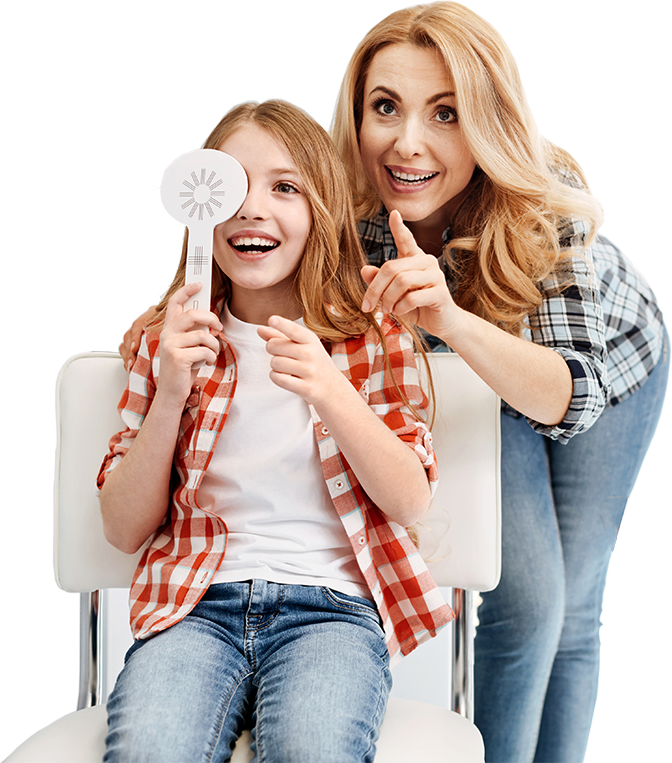The last few decades have seen an astonishing increase in the prevalence of children’s myopia. Why is it happening and what can you do about it?
What is Myopia?
Myopia (or nearsightedness) is very common. One out of two people (50%) have it. With myopia, the eye is longer than normal from front to back, or the cornea (the clear window at the front of the eye) is too steeply curved. This makes things that are far away from you look blurry.
We understand how frustrating everyday life can be for children with uncorrected nearsightedness. Our doctors are committed to providing the best advice and treatment for this all-too-common problem-myopia.
Signs Your Child May Be Nearsighted
Children with myopia have difficulty seeing things at a distance, which may be demonstrated by sitting too close to the television, squinting, or difficulty in school because they can’t see the board. They might also complain of “tired eyes” or headaches when trying to see something far away.
These signs shouldn’t be passed off as just childhood quirks. Too often, parents don’t realize the importance of early vision care, and wait far too long to have their child’s vision checked. Generally, baby’s first full eye exam should be at six months, then at age three, then before entering first grade.
Prevention Could Be Surprisingly Simple
Recent studies suggest a straightforward reason for skyrocketing rates of myopia in children: they aren’t spending enough time outside! Before modern times, when children spent most of their time out under the sun, it’s believed that the bright, natural light helped developing eyes focus correctly. While there is no proven direct link, research suggests that children who spend more time indoors doing near-focused activities (such as computer work, video games, and reading) have higher rates of myopia than those who spend more time outdoors.
Dim, artificial indoor lighting doesn’t seem to provide the same benefit. This difference may be causing the eyeballs of children who spend too much time indoors to grow oblong, unable to focus on distant objects. So, the next time your child is looking for something to do, suggest something outdoors! Just a couple hours of sun a day could make all the difference!
Top Myopia Treatments
There are several treatments available to control Myopia. Talk with one of our doctors about myopia control and the best treatment for your child or for you. Here are some of the most common treatments available now…
Low-dose Atropine eye drops
You may be familiar with Atropine eye drops. They are used to widen your pupils during an eye exam. When given to children in small amounts for 2 to 3 years, the drops may slow the progression of myopia. Doctors do not know exactly how it works, but they think these drops may keep the eye from lengthening too much. Myopia worsens as the eye grows longer.
Low-dose atropine for myopia is used for children between 5 and 18 years old. The drops are placed in the eye each night at bedtime. Side effects of atropine drops at low doses may include redness or itchiness around the eye.
Peripheral defocus contact lenses
These special contact lenses are worn by children 6-12 years of age with myopia. This “multifocal” contact lens has different areas of focus. Think of this type of lens as looking like a dartboard, with multiple circles inside of each other. The center of the lens, or “bull’s-eye,” corrects blurry distance vision, while the outer portions of the lens “defocus” or blur the child’s peripheral (side) vision. Blurring side vision is thought to slow eye growth and limit myopia.
Peripheral defocus contact lenses might not work in all cases. However, these lenses seem to help certain children, including those whose parents are nearsighted and whose own myopia is getting worse.
Like any contact lens, there is a risk of getting a corneal infection. Be sure your child can correctly wear, clean, and store the contact lenses to avoid infection.
Orthokeratology (Ortho-K)
Orthokeratology is a contact lens that a child wears overnight to correct blurry distance vision during the day. Also called Ortho-K, the lenses flatten your cornea while you sleep. The next day, light passing through the reshaped cornea falls precisely on the retina, making distant images appear clearer.
Wearing Ortho-K lenses only improves vision for a short time. Once you stop wearing the lenses, the cornea slowly goes back to its normal shape and myopia comes back. Still, ortho-K may provide some permanent reduction in myopia progression.
There is a risk of infection with Ortho-K lenses. They are also more difficult to fit compared to regular contacts lenses, and more follow-up visits to the doctor are needed.
Myopia Doesn’t Have to Limit Your Child
Correcting myopia in children requires close monitoring because their eyes are changing so rapidly, and often don’t stabilize until their 20s! However, even during all this change, your child can enjoy full, clear vision.
Whether the best choice is glasses, contacts, or other treatment, we understand that the optimal vision correction solution is one that’s tailored to each individual patient.
Thank you for choosing us as your family’s partners in lifelong vision health. We treasure the trust you place in our practice!
Top image by Flickr user Randen Pederson used under Creative Commons Attribution-Sharealike 4.0 license. Image cropped and modified from original.
The content on this blog is not intended to be a substitute for professional medical advice, diagnosis, or treatment. Always seek the advice of qualified health providers with questions you may have regarding medical conditions.

